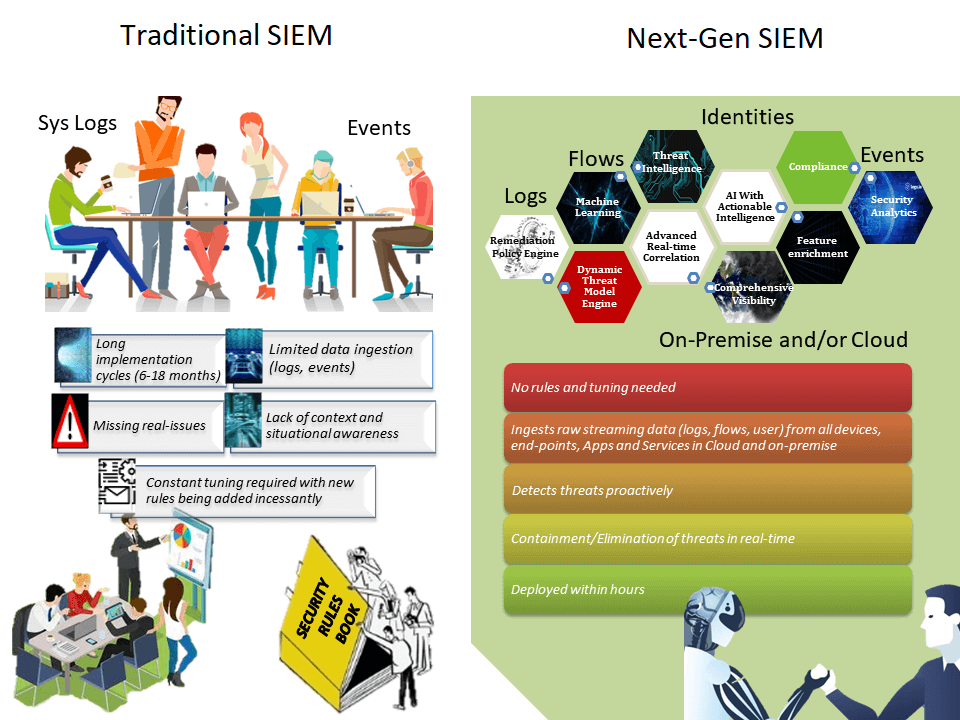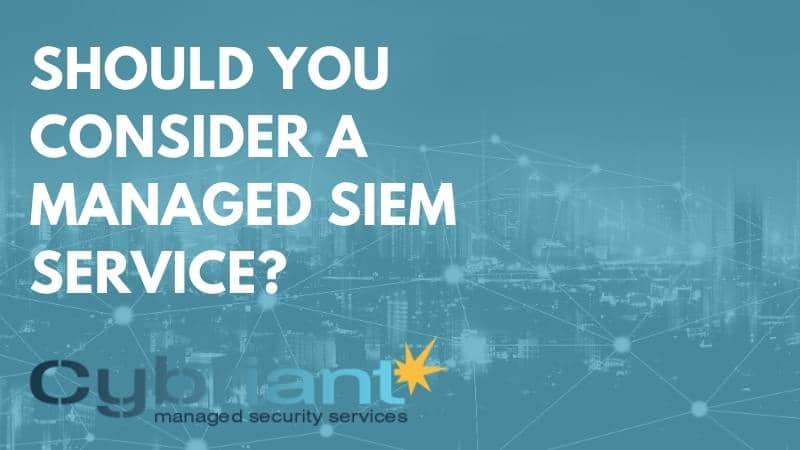While a SIEM is a vital tool for monitoring networks, could a Managed SIEM service make an impact on your business?
What is a SIEM?
Security information and event management (SIEM) is an approach to security management that combines SIM (security information management) and SEM (security event management) functions into one security management system.
The acronym SIEM is pronounced “sim” with a silente.
The underlying principles of every SIEM system is to aggregate relevant data from multiple sources, identify deviations from the norm, and take appropriate action.
For example, when a potential issue is detected, a SIEM might log additional information, generate an alert, and instruct other security controls to stop an activity’s progress.
Payment Card Industry Data Security Standard (PCI DSS) compliance originally drove SIEM adoption in large enterprises but concerns over advanced persistent threats (APTs) have led smaller organizations to look at the benefits of a SIEM and what a managed security service provider (MSSP) can offer.
Read more: Do you need a SIEM to be PCI Compliant?
Being able to look at all security-related data from a single point of view makes it easier for organizations of all sizes to spot patterns that are out of the ordinary.
Today, most SIEM systems work by deploying multiple collection agents in a hierarchical manner to gather security-related events from end-user devices, servers, network equipment, as well as specialized security equipment like firewalls, antivirus, or intrusion prevention systems.
The collectors forward events to a centralized management console where security analysts sift through the noise, connecting the dots and prioritizing security incidents.
What is Managed SIEM?
Managed SIEM is the process of outsourcing the monitoring of your SIEM to an outsourced security provider. Many organizations take advantage of a Managed SIEM service because they are able to leverage the expertise of security professionals on an around the clock basis. You are also able to reduce training costs, gather greater threat intelligence, and scale faster.

Questions About Managed SIEM Pricing
Cybriant’s Managed SIEM service pricing is based on a number of different variables. These variables include the level of support, software licensing cost, number of devices, and post-implementation services. To request a quote, fill out our form here.
Is Managed Security Right For You?
A SIEM is a complex tool that requires expertise to implement and maintain. To be effective, a SIEM has to be constantly updated and customized because external threats and internal environments are constantly changing.
It requires experienced security engineering to tune the SIEM to minimize false positive alerts and maximize the efficient detection of real breaches or malicious behavior.
Managing a SIEM ain't easy
Utilizing and managing a SIEM in-house is typically reserved for large organizations that have the budget for developing a large, specialized team. Deploying a fully managed SIEM also means that your team consists of security analysts that oversee your system around the clock and calendar. This is their one and only dedicated job, and not an additional task for an already overworked engineer.
If you need help with any of the following questions, then a managed SIEM may be right for your organization. Learn more about our Managed SIEM service.
- Does your company have a framework-based security program?
- Are you required to keep up with compliance regulations or IT audits?
- How are you meeting requirements or IT audits?
- Do you have a SIEM? Inhouse or Outsourced?
- Are you receiving the business value you expected from your SIEM?
- Are you considering deploying a SIEM?
- Are you constrained by time, resources, or budget?
Managed SIEM Use CasesRegulatory.
All major regulatory acts require affected companies to implement procedures to regularly review records of information system activity, such as audit logs, access reports, and security incident tracking reports. This includes regulations such as PCI-DSS, HIPAA, GLBA, and others that impact industry verticals like Retail, Healthcare, Financial Services, Government, and Education. A properly implemented SIEM captures, stores, and analyzes this information.
Supply Chain Framework and Compliance.
Many clients have contractual requests based on their framework. Cybriant’s services are aligned with the NIST Cybersecurity Framework.
Cyber Risk Management. Properly implemented SIEMs are essential to the discovery of the most sophisticated cyber attacks known as advanced persistent threats (APTs), and aid in ensuring other defense tactics and tools are operating effectively.
Why Managed SIEM?Limited IT Staff.
Most midsize and lower enterprise organizations lack the in-house IT staff required to maintain the tools they have in place, much less implement and manage new security products. Nor do they have adequate personnel coverage for 24/7 monitoring, analysis, and response.
Lack of Security Expertise.
In addition to not having enough IT staff, midsize and lower enterprise companies lack the security expertise necessary to research, analyze, and understand threats, leaving them woefully under-prepared to effectively respond to a cyber attack.
Insufficient Budget.
Trying to build and maintain an in-house security team with the necessary skills and tools to be effective is not only difficult, but it’s also expensive and beyond the means of most mid-size and lower enterprise companies that are contending with limited IT budgets.
Dynamic Computing Environments.
The rising adoption of cloud services and mobile computing has led to a dynamic IT infrastructure with a porous perimeter and growing attack surface, which is far more difficult to defend, especially for under-resourced teams.
Benefits of Managed Services vs. In-House Services
It’s tempting to consider your in-house IT team to take care of your SIEM, but is it the right decision for your business?
If you’re like most businesses, you’re always on the lookout for ways to save money while improving results. Sometimes this means expanding your staff to include a team of tech specialists at your beck and call, but this can often be an unnecessary expense that leaves you with highly paid employees twiddling their thumbs all day.
For organizations who are looking for the best of both worlds, we recommend Managed Security Services.
Put simply, Managed SIEM gives you a team of specialist 24/7 security analysts and network experts – and at a fraction of the cost. Naturally, you’d rather see your IT budget working to support your growth and kept as low as possible.
That’s our focus too, and why we don’t simply maintain and repair your systems, we proactively monitor to avoid downtime and work with you to ensure your IT increases productivity and efficiency. Whether you already have in-house IT and are auditing the value, or are curious about what having IT support might be like for your business, we’ve put together a few factors to consider before making your choice:
Availability:
Most employees work 9-5, but what happens if something goes wrong with your systems outside these hours? Our team is monitoring your SIEM on a 24/7 basis and will only alert your team if a major incident is detected.
Total cost:
If you have considered building a Security Operations Center (SOC) for your organization, take a few minutes to download the ebook, Insource vs. Outsource: Cost Comparison for Building a 24/7 Security Operations Center. We will take you through the exact costs of building an internal SOC for a medium-sized business and compare it to the costs of outsourcing to a cybersecurity firm like Cybriant.
Ongoing Training:
Putting aside the fact your internal team will often spend entire weeks away upgrading their skills and leaving you scrambling for support while they’re gone, those training costs quickly add up. With a salaried SOC, you’ll have to pay all ongoing training and certification costs, plus travel costs for industry conferences. We know how important it is to remain current, certified, and skilled in new technologies, so we spend the money to invest in ourselves so we can serve you better. We’re part of industry-related communities and attend multiple conferences each year, all at our own expense.
Different goals:
For most employees, a higher wage is the goal and many will job-hop to achieve that. Internal security analysts may be looking for the first opportunity to leave and get paid more, often leveraging all the training you’ve just provided. In these modern times, switching jobs regularly is expected, with an average of only 3 years in each position. Considering how much it costs your business to acquire, train, and upskill your technician, 3 years is an unreasonable ROI. Our goals couldn’t be more different – we only aim to keep you a happy customer for as long as we can!
In the end, your business needs to find the right balance between profit and expertise. When you partner with our Managed security services, you’re securing availability, ever-increasing expertise, and commitment to your success. We work closely with you to provide the very best support and protect you from costly disasters, taking preemptive action to keep you safe and operational. There’s no doubt our Managed SIEM service is a better decision than building an in-house SOC, and we’d be delighted to prove it to you.
Managed SIEM Solutions
SIEM (Security Information and Event Management) is a critical component of any organization’s cybersecurity strategy. A SIEM system helps businesses to monitor and analyze their IT infrastructure’s security alerts, threats, and vulnerabilities. However, managing a SIEM system can be a daunting task, as it requires a lot of resources, expertise, and time. This is where SIEM service providers come into the picture.
SIEM service providers are companies that offer cybersecurity services to businesses, including SIEM management, maintenance, and analysis. These providers offer a range of SIEM solutions, from SIEM as a Service (SaaS) to managed SIEM services. In this article, we’ll explore the different types of SIEM service providers available, their benefits, and how to choose the right provider for your organization.
Managed SIEM Providers
Managed SIEM providers offer fully managed SIEM services to businesses. With managed SIEM services, companies outsource the entire SIEM management process to the provider, including SIEM deployment, configuration, monitoring, and analysis. Managed SIEM providers offer a comprehensive range of services, including 24/7 security monitoring, incident response, and threat intelligence.
SIEM service providers also differ in the level of security monitoring they offer. Some providers offer essential security monitoring, while others offer advanced threat detection and response. Businesses need to choose a provider that offers a level of security monitoring that aligns with their IT infrastructure’s security needs.
In addition to security monitoring, businesses need to consider the level of expertise and support offered by SIEM service providers. Providers with experienced and skilled cybersecurity professionals can help businesses detect and respond to security threats more effectively. Also, providers that offer 24/7 support can provide quick assistance in case of security incidents.
In conclusion, SIEM service providers offer a range of solutions to help businesses manage their cybersecurity risks effectively. Whether you choose a managed SIEM provider, it’s crucial to consider the cost, level of security monitoring, expertise, and support offered by the provider. With the right SIEM service provider, businesses can focus on their core operations while having peace of mind knowing that their IT infrastructure is secure.
SIEM Cost Comparison
When comparing the prices of a SIEM, it’s vital to consider the following factors: features, capabilities and limitations, deployment and integration, scalability, customizability, and overall effectiveness of each solution.
USM Anywhere offers an all-in-one security solution with features such as log management, threat detection, and incident response. It is highly customizable and easy to use, making it an ideal solution for small to medium-sized businesses. However, its pricing structure can be quite complex, with licensing fees ranging from $2,000 to $10,000 per year, and additional costs for professional services.
Seceon is a cloud-based SIEM solution that provides real-time threat detection and response. It offers a wide range of features, including automated threat response, machine learning, and behavioral analysis. Seceon’s pricing structure is flexible, making it an affordable option for businesses of all sizes. Its licensing fees range from $20,000 to $100,000 per year, with additional costs for professional services and on-premise deployment.
Google Chronicle is a cloud-based SIEM tool that uses machine learning to detect and investigate security threats. It offers a user-friendly interface and integrates with a wide range of third-party security tools. Google Chronicle’s pricing structure is usage-based, with costs ranging from $0.10 to $1 per gigabyte of data processed, making it a cost-effective option for businesses of all sizes.
In terms of realistic use cases, USM Anywhere is ideal for small to medium-sized businesses that require a highly customizable solution. Seceon is suitable for businesses that require a cloud-based solution with advanced threat detection capabilities. Google Chronicle is suitable for businesses that require a scalable and cost-effective cloud-based solution.
When exploring the tradeoffs of deploying an open-source or cloud-based SIEM tool versus a commercial one, it is important to consider factors such as customization, scalability, support, and security. Open-source solutions may be more customizable and cost-effective, but they may lack the support and security features of commercial solutions. Cloud-based solutions may be more scalable and cost-effective, but they may not offer the same level of customization as on-premise solutions.



